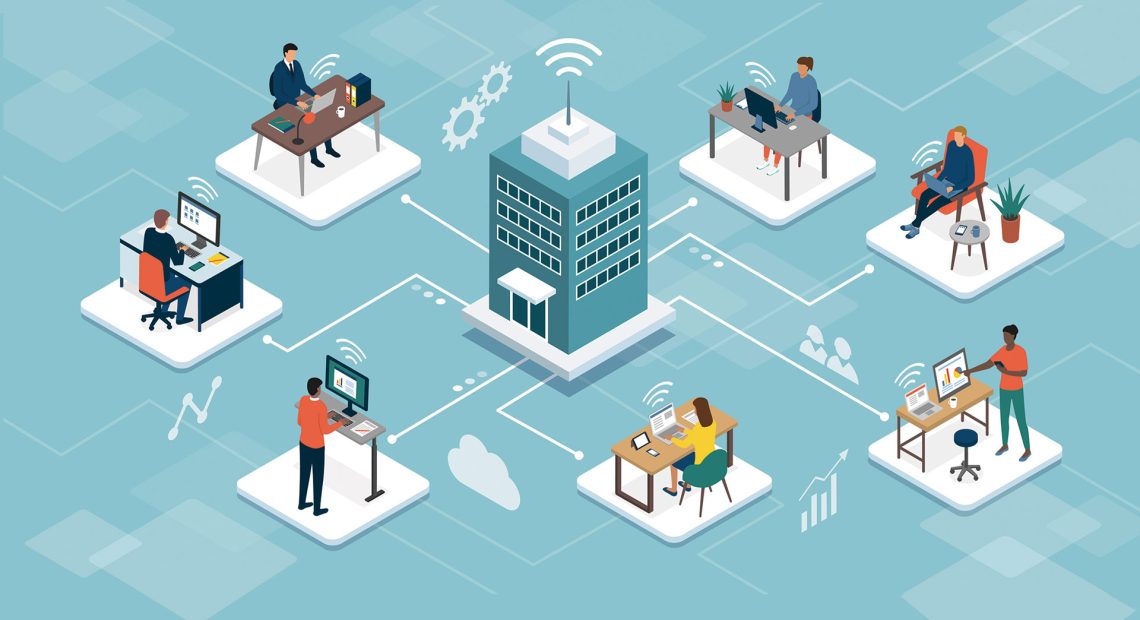Home Sweet Home

Make no mistake, Meredith Wise says — employers miss those bustling offices where all their employees used to come to work.
And after almost three years of remote work — during which the practice evolved from a temporary necessity to a ubiquitous reality — businesses are definitely grappling with what it all means, and whether they can slow the remote train down.
“A lot of businesses would like to have people back in the office,” said Wise, president of the Employers Assoc. of the NorthEast. “They’re struggling a bit with communication, with employee relations, and with staying in touch with people and knowing what’s going on with them.
“The idea used to be that people would come in, and you’d get a sense of how their night went, how their morning was going,” she added. “With Zoom communications, you just don’t get that same feeling. A lot of companies are feeling like they’re losing that personal connection with employees.”
Even some of the largest employers feel that way, as Walt Disney Co. workers found out in a recent internal memo from CEO Bob Iger, who is calling on all workers to spend at least four days a week in the office, starting March 1.
“In a creative business like ours,” Iger wrote, “nothing can replace the ability to connect, observe, and create with peers that comes from being physically together, nor the opportunity to grow professionally by learning from leaders and mentors.”
Still, Wise noted that many local companies seem to be moving in the opposite direction, by continuing to embrace hybrid schedules. “They’ve found productivity can be better when working from home remotely, where people don’t have any of the distractions of being in an office, and I think that hybrid model is going to stay.”
Amy Roberts, executive vice president and chief Human Resources officer at PeoplesBank, agreed.
“A lot of businesses would like to have people back in the office. They’re struggling a bit with communication, with employee relations, and with staying in touch with people and knowing what’s going on with them.”
“We implemented a flexible work-arrangement policy in the midst of COVID, and we still have a lot of people working hybrid, with some time in the office and some time working from home,” she told BusinessWest. “It really depends on the area a person works in and what the business needs are. We have a couple fully remote workers; we actually hired a person out of Illinois who works fully remotely.”
Like Wise, Roberts said it’s easy to see why remote work is appealing, from the elimination of commuting time to creating a focused work environment. “I think the flexibility of it is really helpful to people in terms of work-life balance. Or they might say, ‘I really need to get X done, and doing this particular work is best done when I’m home, so I can focus more.’”
Roberts said many companies are starting to pull everyone back into the office — especially businesses that stress a collaborative culture or require plenty of face-to-face work with customers — but not all. “I do think the hybrid model is here to stay, though I don’t think it works for everyone.”
Seth Stratton, managing shareholder with Fitzgerald Law in East Longmeadow, noted that, like many small businesses, his firm never fully left the office during the pandemic, and these days, everyone has been back for some time. But they have continued to use communication tools, like Zoom, that became popular when employees at most companies were at home.
“We were forced to embrace some technology and ways of working that carried over and make work more flexible, even though we’re back in the office.”
Stratton understands the value of remote work in some situations, drawing on examples from his own career.
“During the peak of the workday in the office, there are a lot of interruptions, and a lot of times, when I’m focused on revising a lengthy contract or drafting a legal brief to submit to court, I need time to focus mentally on what I’m doing, so historically, a lot of that will be done early in the morning or later in the evening, after the phone stops ringing,” he said, noting that working from home can create more time and space for such work.

Seth Stratton says remote work can reduce distractions, but also hinder communication and collaboration.
On the other hand, someone in a home office can’t just walk into the next room to tap someone else’s expertise.
“You can do that remotely, but it’s harder to get on the cell or set up a Zoom meeting; it’s not as seamless as walking 10 feet away. That affects you from a collaborative standpoint.”
And collaboration happens outside the office, too.
“In Western Mass., probably moreso than other markets, when it comes to business generation, marketing, and client development, this is a parochial business community; a lot of business is conducted through personal relationships, personal connections,” Stratton explained. “I might be having lunch at the Fort or at Nadim’s and see someone I know — ‘oh, I’ve been meaning to call you; let’s schedule a call. Or do you have a minute now?’
“It’s harder to make those connections when you’re fully remote,” he went on. “Being available, I think, is a hallmark of business development in Western Mass., at least in my experience.”
Successful Experiment
While it may have eventually surprised employers how effective their teams could be at home, Wise recalled the challenge of those first few weeks in March 2020.
“When it first started, nobody really had the computer setups or the communication tools to be able to work remotely from home,” she said. “Now, people are more able to work at home and be productive.”
These days, “while we have found some companies saying, ‘we want all employees in the office Monday through Friday,’ those are few and far between. Instead, what a lot of employers are saying is, ‘you know what your job requires; work with your manager on what days you need to be in the office and what days you can work at home.’”
As a Baby Boomer, Wise said, she understands the old-school mentality of employers who have always been able to see their employees at work, and may be hesitant to give that up.
“It can be a hurdle to get over that perspective that ‘I can’t see you, so are you working?’ Part of the communication piece is doing a better job as organizations to define productivity and what needs to happen on the job. And it’s been good for leaders and workers to tighten up some of the parameters — ‘you know what’s expected of you, and you and I need to set that ahead of time, because things can easily get out of hand if you’re not here every day.’”
It makes sense to put those parameters in writing, said John Gannon, a partner with the law firm Skoler Abbott in Springfield. “The accountability policy needs to be clear. I’ve seen policies that say, ‘we need to see proof that your children are in daycare.’ I’m not sure if I’d recommend going that far, but certainly the supervisors need to be paying attention to their employees when they’re home.”
Zoom meetings help, he said, but employees are still unmonitored for the vast majority of the workday. Some companies have even installed technology on home computers that logs keystrokes per hour.
“If they have employees working remotely, even in a hybrid fashion, in another state — which is not uncommon given Springfield’s proximity to Connecticut — they have to be cognizant of which state’s employment laws apply.”
John Gannon
“I don’t like that, personally,” Gannon went on. “But it’s an option for employers if they have concerns that the hybrid model results in less productivity. I wouldn’t recommend it unless an employer is having problems, because it is a privacy issue, and a lot of this comes down to trust; you want to trust your employees, and you don’t want to set up a model that says you don’t trust them.”
Wise has heard of keystroke monitoring as well, and said most employers in this region aren’t looking to go there. But they’re also still in an experimental stage when it comes to remote and hybrid schedules.
“A lot of organizations are still feeling this out — ‘let’s try this for six months; I know we did it during the pandemic, but let’s try it in the new year and see if it works out, or whether we need to make adjustments to it.’ Handbooks and policies are still catching up.”
And if employers have employees working remotely in a different state, Gannon added, they need to update that handbook to make sure employees in those states are getting a handbook with laws applicable to that state, and also make sure the company is registered to do business in that state.
“If they have employees working remotely, even in a hybrid fashion, in another state — which is not uncommon given Springfield’s proximity to Connecticut — they have to be cognizant of which state’s employment laws apply,” he explained. “If they’re working from home three or four days a week and coming in one or two days a week, their primary office is their home, and if that’s in Connecticut, they’re subject to Connecticut employment laws and Connecticut employment taxation.
Those laws touch on everything from paid family medical leave and sick time to injuries on the job.
“It may sound crazy, but you may have to address workers’ compensation,” Gannon said. “If you’re walking down your stairs in the morning to go to your home office, that’s not covered, but in your home office, if you fall out of your chair and hurt yourself, that may be covered.”
Losses and Gains
Roberts agreed that there’s an interesting dynamic at play now, with some employers worried they don’t have eyes on their employees, while others fret about losing office culture and the ability to keep workers engaged.
“How do they know if they’re happy, if they’re productive, if they’re getting what they need from their career development? If you don’t see them all the time, how do you mentor? There’s a lot of questions managers are grappling with when it comes to this new style of work.”
That said, employers who embrace remote and hybrid schedules are able to cast a wider net in recruitment, at a time when talent is difficult to come by.
“We’ve been able to advertise positions as hybrid, which certainly brings more candidates our way,” Roberts said. “People are looking for that flexibility, and if you’re able to offer a fully remote situation, you can hire someone from anywhere; you have the ability to get the best available talent. Unfortunately for us, a lot of our positions are hybrid or in the office or banking center; we don’t have the luxury of large companies that are fully remote — but we’ve increased the candidate pool for sure.”
Stratton said the tools of remote business has helped his firm expand its client base beyond Western Mass.
“It allows us to reach out geographically with clients because clients are used to working by Zoom meeting and don’t feel that same compulsion to meet in person that they used to,” he said. “That’s given us more flexibility to actually grow our footprint a little more.”
And grow it into regions where legal services cost more than they do in the 413, he added. “We always had a pricing advantage over areas like Eastern Mass. and Southern Connecticut, and we can more easily use that pricing advantage to our benefit by expanding our footprint and working farther outside Western Mass.”
Though hybrid work may be here to stay, Stratton said, most of his firm’s clients are small to medium-sized businesses, and the majority of them have emphasized getting workers fully back in the office, though some are embracing hybrid work schedules and remote-work tools.
“A lot of large, national corporations, you see fully remote, where a lot of their workers are in different offices anyway, so it’s less impactful to be spread out,” he added. “But small to medium-sized businesses in this area, in my experience, are generally pushing toward being back and find it more effective, which is consistent with our experience as a small business.”
There’s no one-size-fits-all model, however, and Roberts said everyone is still grappling with the new work styles and how to make them effective.
“We need to figure out how to mourn the loss of the old way and transcend to a new way of working. It’s not the same as it was 15 years ago, maybe even 10 years ago, where you were identified by the office you worked in, and you had celebrations and events, things happening there. It’s different now; people are looking for a different way of working, and employers have to think differently.”






